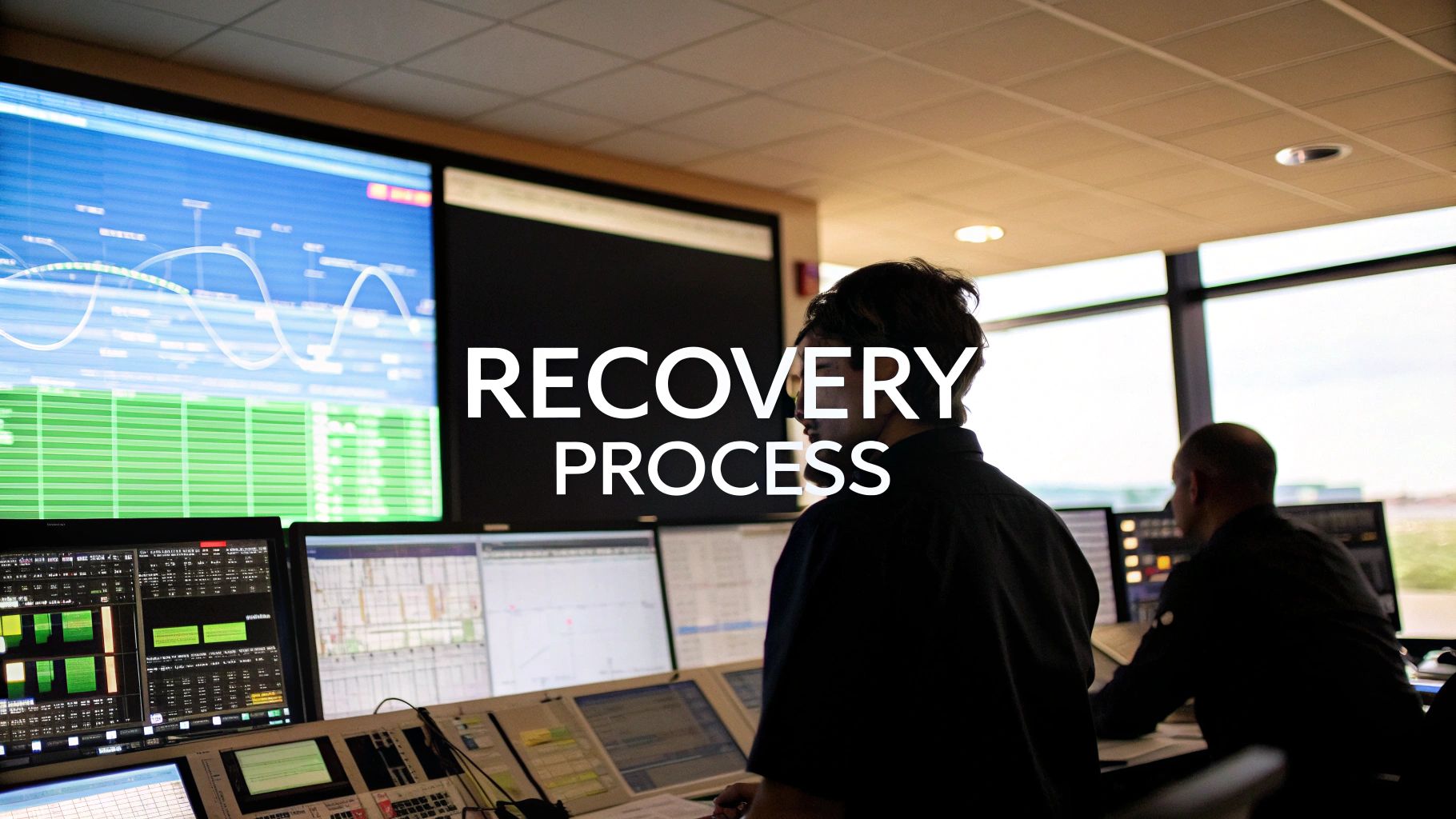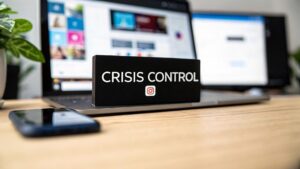In a digital age where opportunities continuously evolve, affiliate marketing...
Read More
The Anatomy of Social Media Crises

Social media has drastically changed how businesses operate, particularly in crisis management. Situations that were once handled privately now unfold in the public eye. This necessitates a new approach to handling social media crises, one that understands the core components of a social media crisis and differentiates them from typical customer service issues.
Identifying True Crises
A true crisis is more than just a negative review or a customer complaint. It's an event that significantly threatens your brand's reputation and profits. A product defect that goes viral, for example, could be considered a crisis. A single unhappy customer, however, probably isn't. The difference lies in the potential for widespread negative impact. Each organization needs to define its own crisis thresholds based on the potential damage.
Understanding the Evolution of a Crisis
Social media crises unfold quickly. A single negative tweet can escalate into a major public relations disaster in a matter of hours. The sheer number of social media users fuels this rapid acceleration. As of April 2023, there were roughly 4.8 billion social media users globally. This represents about 59.9% of the world's population and 92.7% of global internet users. This widespread usage makes proactive crisis management essential. Find more detailed statistics here for a deeper understanding of social media's growth and impact on crisis management. Businesses now need to develop sophisticated crisis management strategies to navigate this new reality.
Categorizing Crises
Effectively managing a social media crisis starts with understanding the different types that can arise. Here’s a general overview:
- Product/Service Failures: These stem from problems with your offerings, such as defects, safety issues, or poor performance.
- Customer Service Mishaps: Negative customer service interactions, particularly those that gain widespread attention, can quickly escalate.
- Public Relations Blunders: Misguided marketing campaigns, insensitive remarks, or controversial company actions can all trigger online outrage.
- Misinformation/Disinformation: False or inaccurate information about your brand can spread like wildfire, damaging your reputation if not addressed.
For a more thorough understanding of reputation management in challenging times, check out this guide: Social Media Crisis Management: The Expert Guide to Building Brand Resilience. Recognizing these different crisis types is the first step in creating a strong social media crisis management strategy. By accurately identifying the nature of a crisis, organizations can tailor their responses for the best results.
The Golden Hour: Response Timing That Saves Brands

In the world of social media crisis management, timing is everything. The first hour after a crisis hits – often referred to as the Golden Hour – can significantly influence the outcome. This crucial window often shapes public perception more than the final resolution. A quick and appropriate response can minimize the damage, while inaction can escalate the situation into a major problem.
Why Speed Matters in Crisis Response
Negative sentiment can spread across social media with surprising speed. One negative post can quickly multiply, impacting a wide audience. This requires a proactive response to stop this spread before it gets out of control.
A delayed response allows misinformation to take hold, fostering distrust and damaging your brand’s reputation. This can result in lost customers, reduced sales, and long-term reputational harm.
The Challenge of Rapid Response
One of the key challenges in social media crisis management is the ability to quickly anticipate and respond to emerging crises. On average, it takes about 18 hours and 57 minutes from the first sign of trouble to the first news report. This timeframe is essential for organizations to evaluate the situation, develop a response, and implement it effectively.
Real-time social media analytics and AI technologies can help businesses assess public sentiment and identify key influencers. This allows for timely interventions to manage the narrative and mitigate potential damage. However, predicting crises remains difficult due to the ever-changing nature of social media trends and user behavior. Learn more about social media crisis management here.
Realistic Response Benchmarks
Different team sizes have varying response capabilities. A large company with a dedicated crisis management team might respond in minutes, while a smaller business might need more time. Setting realistic benchmarks is essential.
- Small Teams (1-3 people): A response within 1-2 hours is a good target.
- Medium Teams (4-10 people): Aim for a response within 30 minutes to 1 hour.
- Large Teams (10+ people): A response within 15-30 minutes should be the goal.
These are general guidelines, and the ideal response time will depend on the nature of the crisis.
Overcoming Approval Bottlenecks
Slow approval processes can hinder a timely response. Streamlining approvals is essential for effective crisis management.
- Pre-Approved Messaging: Having pre-approved messages for common crisis scenarios can save valuable time.
- Designated Spokesperson: Empowering a designated spokesperson to communicate directly, without multiple layers of approval, speeds up the process.
- Clear Escalation Paths: Established escalation paths for critical decisions ensure that important issues are addressed quickly.
By implementing these strategies, businesses can navigate crises more effectively. This preparedness allows for rapid action, minimizing negative impact and potentially transforming a challenging situation into an opportunity to demonstrate brand resilience and customer focus.
Crafting Your Crisis Management Playbook
A generic social media crisis management plan simply won't work. You need a customized playbook that truly reflects your unique brand, audience, and potential vulnerabilities. This requires a structured approach that goes beyond the basics.
Classifying Your Crises
First, you need to establish clear crisis classification parameters. Not every negative comment or disgruntled customer signifies a full-blown crisis. Define specific thresholds based on the potential impact an issue could have on your brand.
To illustrate, consider these levels:
- Level 1: Minor issues (e.g., an isolated customer complaint). These typically only require a standard customer service response.
- Level 2: Moderate concerns (e.g., a negative review gaining traction online). These situations necessitate a more proactive social media response to address the growing concern.
- Level 3: Major crises (e.g., a product recall, widespread negative publicity). These scenarios trigger the full crisis management protocol, demanding immediate and comprehensive action.
Clearly defining these levels helps prevent both overreaction to minor issues and dangerous complacency in the face of real threats. This measured approach ensures your resources are allocated appropriately and efficiently.
To further clarify this classification system, the following table provides a detailed breakdown of each severity level:
Crisis Severity Classification System
A framework for categorizing social media crises by impact level and determining appropriate response strategies.
| Severity Level | Characteristics | Response Requirements | Example Scenarios |
|---|---|---|---|
| Level 1: Minor | Isolated incidents, limited reach, minimal brand impact. | Standard customer service response, individual engagement. | A single customer complaint on Twitter, a negative comment on a recent Facebook post. |
| Level 2: Moderate | Growing negative sentiment, increased online visibility, potential for reputational damage. | Proactive social media engagement, public acknowledgement of the issue, targeted communication to affected parties. | A negative review gaining traction on Yelp, a small group of customers experiencing similar technical issues. |
| Level 3: Major | Widespread negative publicity, significant brand damage, potential legal or financial repercussions. | Full crisis management protocol activation, coordinated communication across all channels, transparent and timely updates, engagement with media and key stakeholders. | A product recall, a data breach, accusations of unethical business practices going viral. |
This table provides a clear framework for assessing the severity of a social media crisis and tailoring the appropriate response. By understanding these levels, your team can react swiftly and efficiently to mitigate potential damage.
Preparing Platform-Specific Responses
Different social media platforms require different approaches. What works on Twitter may not be suitable for Facebook. Develop platform-specific response templates that maintain a consistent brand voice. A tweet, for instance, might be brief and direct, while a Facebook post might offer a longer, more detailed explanation. This consistency is key to building trust and reinforcing your brand identity.
As part of your platform-specific preparation, create templates for acknowledging a problem, providing updates, and directing audiences to further information.
Establishing Communication Hierarchies
Clear communication is vital during a crisis. A stakeholder communication hierarchy helps prevent mixed messaging and ensures everyone is on the same page. Define who communicates with whom, and through which channels.
Consider these communication lines:
- Internal Communication: Team leads provide regular updates to their respective teams, ensuring everyone is aware of the situation and understands their roles.
- External Communication: A designated spokesperson addresses the public and media, providing a consistent and authoritative voice for your brand.
This structured approach prevents confusion and ensures accurate information dissemination throughout the crisis.
Streamlining Approval Workflows
Rapid response is crucial in social media crises. Implement approval workflows that balance necessary oversight with the speed required to address developing situations. Pre-approved messaging for common scenarios can save valuable time.
Empowering designated individuals to respond without multiple layers of approval can expedite the process. A clear chain of command is essential for quick and effective decision-making.
Running Reality-Based Simulations
Practice makes perfect, especially when it comes to crisis management. Conduct crisis simulations to test your playbook and identify any vulnerabilities. This practice allows your team to experience realistic scenarios and refine their responses under pressure. Simulations are invaluable for exposing weaknesses and improving your overall preparedness.
Don’t limit yourself to one type of crisis. Testing different crisis scenarios, such as product failures, PR blunders, and negative social media campaigns, is essential for building a resilient and adaptable social media strategy. By running these simulations, you'll be much better equipped to handle any crisis that comes your way.
Predictive Analytics: Preventing Crises Before They Erupt

While responding quickly to a social media crisis is essential, the best strategy is preventing one altogether. This is where predictive analytics comes in. Forward-thinking brands use social media analytics tools like Brand24 to identify potential problems before they escalate into a crisis. This proactive approach minimizes damage and strengthens a brand's resilience.
Establishing Meaningful Sentiment Monitoring Baselines
Imagine trying to spot a rogue wave in a constantly churning ocean. Without understanding the normal wave patterns, it's nearly impossible. Likewise, sentiment monitoring requires establishing meaningful baselines. These baselines represent the typical range of public sentiment toward your brand.
This understanding allows you to identify genuine anomalies, not just routine fluctuations. For example, a small dip in positive sentiment might be normal after a new product launch. But a sudden, significant drop could indicate a developing crisis.
By tracking sentiment baselines, you gain the context needed to accurately interpret data and take action when unusual patterns emerge. This allows you to respond strategically and prevent negative situations.
Implementing Conversation Pattern Analysis
Beyond tracking overall sentiment, analyzing conversation patterns provides deeper insights. This involves identifying emerging topic clusters and sentiment shifts related to your brand. For instance, if discussions around a particular product feature suddenly turn very negative, that’s a clear warning sign.
This early detection lets you address the issue proactively. Perhaps you can modify the feature or offer improved customer support. Taking preemptive action can prevent negative sentiment from escalating into a full-blown crisis.
To better understand the metrics involved in effective social media monitoring for crisis prevention, consider the following table:
Key Social Media Monitoring Metrics: Essential metrics to track for effective crisis prevention and management
| Metric Category | Specific Metrics | Crisis Indicators | Monitoring Frequency |
|---|---|---|---|
| Sentiment | Positive, Negative, Neutral Mentions | Significant drop in positive sentiment, Spike in negative mentions | Daily |
| Volume | Number of Mentions, Shares, Retweets | Unusual increase in mentions around a specific topic or product | Daily |
| Topic Clusters | Emerging Keywords, Hashtags | Negative sentiment concentrated around a particular feature or event | Real-time/Daily |
| Engagement | Likes, Shares, Comments, Replies | Drop in engagement, Increase in negative comments | Daily |
| Reach | Impressions, Potential Reach | Sudden increase in reach of negative content | Real-time/Daily |
This table summarizes the essential metrics for tracking sentiment, volume, topic clusters, engagement, and reach across social media. Monitoring these metrics and understanding their potential crisis indicators allows you to effectively manage and mitigate potential PR disasters.
Social media analytics plays a vital role in crisis management by providing actionable insights. Approximately 68% of American adults get their news from social media, highlighting the speed of information spread. Real-time analytics allows companies to track a crisis's propagation, identify influential voices, and assess sentiment shifts. This data helps organizations create targeted responses and communicate proactively, minimizing reputational damage and maintaining trust. Explore this topic further here. Effective crisis management also includes monitoring engagement metrics, such as likes and shares, to evaluate communication strategy effectiveness.
Integrating Early Warning Systems Into Operational Decision-Making
Integrating predictive analytics into daily operations turns insights into action. This means building early warning systems that alert relevant teams about concerning trends. These systems should be tailored to your industry's specific risk factors. A food company, for example, might be especially alert to mentions of food poisoning, while a tech company might prioritize data breach concerns.
Building Predictive Models
Think of predictive models as weather forecasts for your brand’s reputation. By analyzing historical data and current trends, you can create models that anticipate potential risks. These models allow you to be proactive, not reactive, addressing emerging issues before they become crises. This proactive approach minimizes the need for full crisis protocols and protects your brand’s reputation.
Predictive modeling can be complex, but even simple models can significantly improve crisis prevention efforts. Start by identifying your key risk areas and collecting relevant data. Over time, you can refine these models to improve their accuracy and effectiveness.
Communication Strategies That Rebuild Trust
When a social media crisis hits, your communication strategy becomes as important as the actions you take. How you communicate determines whether your audience sees your response as genuine or just damage control. Building a communication strategy that fosters trust requires careful planning and understanding audience psychology.
Acknowledging Reality and Maintaining Brand Integrity
Crafting messages during a crisis involves a delicate balance. You must acknowledge the situation without compromising your brand's integrity. This means admitting mistakes when necessary, while also highlighting your brand’s values and commitment to resolving the issue.
For example, if a product defect triggers a crisis, acknowledge the problem directly and outline the steps being taken to fix it. At the same time, reiterate your brand's commitment to quality and customer satisfaction.
Transparency, even when uncomfortable, is paramount. Attempting to deflect blame or downplay the situation often backfires, eroding public trust. An honest and open approach, while potentially painful in the short term, builds credibility and strengthens long-term relationships with your audience.
Tailoring Communication to Different Stakeholder Groups
Different audiences process information differently. Your internal team needs different information than your customers, who in turn require a different approach than media or regulators. A table can help visualize these different communication needs.
| Stakeholder Group | Communication Priorities | Example |
|---|---|---|
| Employees | Internal updates, clear roles and responsibilities, reassurance of job security | Regular team meetings, internal memos |
| Customers | Honest explanations, solutions and next steps, expressions of empathy and commitment | Public statements on social media, email updates |
| Media | Factual accuracy, timely responses, designated spokesperson | Press releases, media interviews |
| Regulators | Compliance updates, legal considerations, proactive cooperation | Official reports, legal statements |
Message Sequencing, Spokesperson Selection, and Channel Choice
The order in which you communicate information significantly impacts how it’s received. Start by acknowledging the crisis and expressing empathy for those affected. Follow up with clear and concise updates, avoiding technical jargon or corporate speak.
Finally, outline the steps being taken to resolve the situation and prevent future occurrences. Choosing the right spokesperson is also critical. A CEO or other high-ranking official can demonstrate the company’s commitment to resolving the crisis.
Alternatively, a subject matter expert might be better suited to explaining complex technical details. The channels you choose should align with your target audience. If your crisis primarily affects your Twitter followers, focus your communication efforts there.
However, a larger crisis may require a multi-channel approach encompassing press releases, website updates, and even traditional media outreach. A well-chosen channel strategy amplifies your message and ensures it reaches the intended audience.
Adapting Your Strategy as the Situation Evolves
Social media crises are dynamic. Your communication strategy must be flexible enough to adapt to changing circumstances. Continuously monitor social media for new developments and adjust your messaging accordingly.
This agility allows you to stay ahead of the narrative and maintain control during a turbulent situation. Consistent monitoring helps you anticipate potential escalations and tailor your responses to address emerging concerns, mitigating further damage.
By adapting your communication strategies, you demonstrate a commitment to transparency and responsiveness, crucial elements in rebuilding trust.
Turning Crisis Into Opportunity: The Recovery Roadmap

Successfully navigating the initial stages of a social media crisis is a significant accomplishment. But the real work begins after the immediate storm passes. How your brand recovers and rebuilds is the true test of crisis management. This phase isn't just about damage control; it's about using the experience to create positive change.
Conducting an Honest Post-Crisis Analysis
Once the dust settles, it's crucial to conduct a thorough post-crisis analysis. This means taking an objective look at your brand's response and finding areas for improvement. The goal isn't to play the blame game but to identify systemic vulnerabilities.
Was your response timely? Did your team adhere to established protocols? Were your communication channels effective? Honest answers to these questions reveal what worked, what didn't, and how to strengthen your social media crisis management strategy.
Developing Authentic Reputation Recovery Campaigns
Rebuilding trust takes more than a simple apology. Your reputation recovery campaign needs to be genuine, not a performance. This means showing real remorse and taking concrete steps to address the root causes of the crisis.
Engage with your audience honestly and transparently. Answer their questions, acknowledge their concerns, and show a genuine commitment to making things right. This open communication builds understanding and reinforces relationships.
Transforming Crisis Learnings into Operational Improvements
Every crisis is a learning opportunity. Use the insights gained to improve your internal operations. Perhaps the crisis revealed weaknesses in your product development, customer service, or internal communication.
Addressing these issues not only strengthens your organization but also builds organizational resilience, making you better prepared for future challenges. This proactive approach is essential for long-term success.
Measuring Recovery Beyond Basic Sentiment Metrics
While tracking sentiment is important, it shouldn't be your only focus. Successful organizations analyze a range of factors, including customer retention rates, website traffic, and overall brand perception.
A comprehensive understanding of your recovery goes beyond basic sentiment analysis. This multifaceted approach gives you a clearer picture of the crisis's impact and the effectiveness of your recovery efforts.
Leveraging the Crisis to Strengthen Relationships
Social media crises, while difficult, can actually strengthen relationships with your audience. By showing genuine care and a commitment to improvement, you can build deeper connections with your customers. This renewed trust can even lead to increased brand loyalty over time.
Ready to build a more resilient brand and protect your reputation? Explore Antdir's resources on digital marketing and crisis management: Learn more about crisis management strategies at Antdir.
Article created using Outrank



